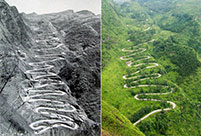

Photo taken on July 20, 2015 shows gold ornaments displayed at a public exhibition of Chinese cultural relics returned by French private collectors, at Gansu Provincial Museum in Lanzhou, capital of Northwest China's Gansu province. [Photo/Xinhua]
Wang Hui, head of the Gansu Provincial Institute of Archaeology, said, "We cooperated with the French to compare the 32 pieces with what our archaeological team unearthed in Dabuzi Hill through comprehensive analysis, including metal components, soil samples and their artistic styles, and finally proved they shared the same birthplace".
Song said there are still other relics from Dabuzi Hill in private collectors' hands.
"Most collectors didn't know that these lost treasures were illicitly expatriated when they bought them," Song said. "So we don't expect them to immediately return their collections back to China. However, we hope they will at least keep the pieces in their hands rather than transfer them somewhere else."
Local villagers first found bronze vessels at Dabuzi Hill in the late 1980s, and about 10,000 people participated in tomb robbery at its peak.
Though the thefts almost ended after a three-year police campaign starting in 1994, Song said Dabuzi Hill remains one of China's two most seriously raided high-level tomb complexes from the Spring and Autumn Period.
While some domestic collectors are willing to buy lost Chinese relics and bring them back home from overseas, Song did not consider that the best solution.
"We don't encourage paying high prices to purchase lost national treasures, which were taken abroad through unusual means in the first place. Diplomatic and legal channels should be used more."
 |  |
 Soldiers serving at Liaoning aircraft carrier
Soldiers serving at Liaoning aircraft carrier Bikini beauties lifeguards in river rafting place
Bikini beauties lifeguards in river rafting place PLA soldiers eat raw snake meat in harsh training
PLA soldiers eat raw snake meat in harsh training Doctors use 3D-printed skull to save girl
Doctors use 3D-printed skull to save girl Kiss contest held in Nanning, SW China
Kiss contest held in Nanning, SW China Yunnan-Myanmar Road: The past and present
Yunnan-Myanmar Road: The past and present Campus belle of Xiamen University gets popular online
Campus belle of Xiamen University gets popular online Who says moms cannot be trendy and hot?
Who says moms cannot be trendy and hot? Eight fruits that defend men's health
Eight fruits that defend men's health  Saffron-collar workers - a Buddhist break
Saffron-collar workers - a Buddhist break One-China should transcend Taiwan politics
One-China should transcend Taiwan politics Celebrity geeks: the worship of China’s top gaokao scorers
Celebrity geeks: the worship of China’s top gaokao scorers Higher state of being: Women practice yoga at 2,000 meters
Higher state of being: Women practice yoga at 2,000 meters Day|Week